The Problem: Bluebirds and Tree Swallows may compete for nest boxes
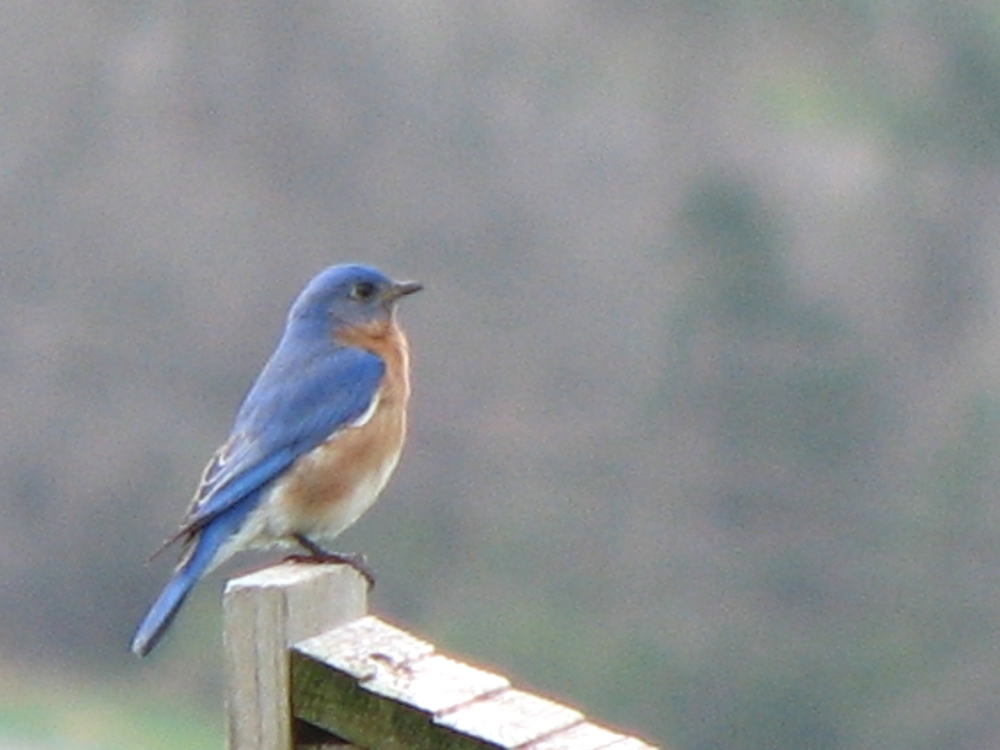
Attention bluebird fanciers and hobbyists: We understand why you love these wonderful birds. We love them too! Bluebirds are always welcome to use our swallow boxes, and when they do we deeply enjoy watching them and comparing their habits with those of our swallows. However, Bluebird versus Tree Swallow competition is a reality; the species can and do compete for nest sites. As a result many bluebird enthusiasts either tolerate the swallows grudgingly or become actively antagonistic toward them. This is unfortunate and unnecessary because there are proven methods for reducing Bluebird – Tree Swallow competition for boxes. Do it right and you can enjoy watching peaceful coexistence between both these beautiful natives!
What’s the main cause of bluebird hobbyist resentment toward Tree Swallows?
We believe that most animosity hobbyists feel toward Tree Swallows comes from the widespread but erroneous belief that bluebirds are in trouble, their very survival in danger unless humans come to their rescue and save them. This alarming notion was first raised in the mid-1900’s. But is there any evidence to support it? We think if you examine the facts you’ll find the answer is no. But please don’t think when we say this we are belittling the efforts of dedicated people to help bluebirds. Far from it! We want to help ease the stress. Therefore, we will present two methods for reducing competition between bluebirds and Tree Swallows, methods that can benefit both species! However, to do this we must unfortunately discredit several widely-held myths that have negatively shaped human reactions to Tree Swallow – bluebird competition.
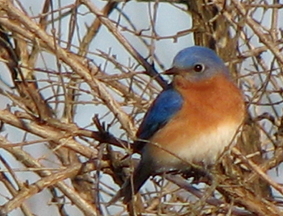
Some Surprising Facts about bluebirds:
Warning: We are going to offer several facts as evidence that bluebirds are not in trouble and do not need preferential treatment over Tree Swallows or any other natives. Unfortunately, these facts will disturb some readers since they conflict with long-held ideas and opinions. For instance, we think it will surprise you to learn that:
- Not one of the three bluebird species is or ever has been classified either endangered or threatened.
- Eastern Bluebirds are not rare. They number over 23 million. This species is actually the third most abundant of the 60-plus species of native North American cavity-nesting land birds. Eastern Bluebirds are even more numerous than Tree Swallows!
- Bluebirds are not the gentle creatures of legend. Quite the opposite. During nesting season bluebirds become extremely territorial and will aggressively attack, injure and sometimes kill other native cavity-nesters, including other bluebirds.
- Eastern Bluebirds were not originally “as common as robins.” Persons stating this have yet to explain where all that short-vegetation habitat those bluebirds would have required was found in the forests that formerly blanketed most of eastern North America.
Clearly, the above facts do not portray species in trouble, but public belief that bluebirds need preferential treatment to survive has continued to cause serious problems for Tree Swallows and those who enjoy them. We need to explore bluebird and Tree Swallow relationships in order to overcome human animosities. To do this we will be exploring these topics in more depth. Please read on.
Which are bigger, bluebirds or Tree Swallows?
There are three species of bluebirds, the Eastern, Western and Mountain. Like Tree Swallows, bluebirds depend on cavities for nesting but are unable to make their own. Bluebirds are significantly larger than Tree Swallows in every major external body dimension but wing length. Bluebirds outweigh Tree Swallows by 30 grams to 20. Despite this, where their ranges overlap swallows will actively compete with bluebirds for the scarce nesting cavities both species need. Pat Grantham’s photo below shows a pair of Western Bluebirds and a Tree Swallow contesting a box in Montana.
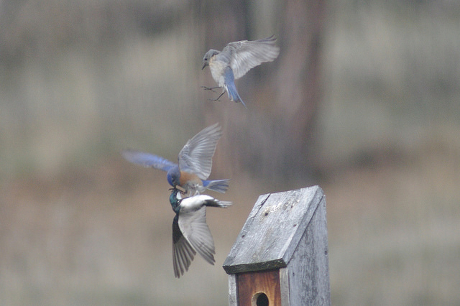
For several decades now there has been a popular and highly publicized movement to erect nest boxes for bluebirds. Many people work hard to “restore” bluebirds to supposed levels of former abundance, and it irritates some bluebird lovers when any other species, especially Tree Swallows, occupy their boxes. We hear the complaint: “Tree Swallows took all my bluebird boxes! They ganged up and drove my bluebirds away!” Are these complaints justified?
Is it right to favor either bluebirds over Tree Swallows, or Tree Swallows over bluebirds?
You may meet people, especially in Eastern Bluebird range, who tell you that encouraging Tree Swallows is wrong. It is not! Bluebirds and Tree Swallows are both native songbirds, equally worthy of care, consideration, and conservation, and Tree Swallows aren’t preventing bluebird “restoration.” One species is not more “desirable” than the other.
But there is still resentment in some quarters when Tree Swallows compete for bluebird boxes, and a minority, hopefully very small, of bluebird hobbyists feels justified to destroy swallow nests and eggs they discover in their boxes. This is sad and unnecessary, and immoral and illegal, especially since there are accepted management techniques for reducing Bluebird – Tree Swallow competition. In the photo below a male Eastern Bluebird defends its box from an intruding Tree Swallow.
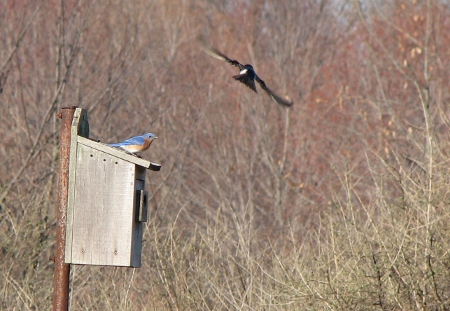
Proper spacing of Bluebird nest boxes is extremely important for reducing Bluebird – Tree Swallow competition!
Reducing competition between Tree Swallows and bluebirds would be much easier if bluebird hobbyists simply followed accepted bluebird box-spacing guidelines. Since bluebirds must defend large feeding territories around their nests they don’t want to nest close to other competing bluebirds. Experts say to space bluebird boxes at least 300′ apart (the length of a football field), preferably even farther. In other words, don’t make clusters of bluebird boxes!
In contrast to bluebirds, Tree Swallows do not defend feeding territories, just a small area approaching and around their nest. For this reason Tree Swallows will nest in boxes spaced as close as 100′ apart, or even closer. This means many pairs of swallows can potentially nest within an area that will only support one pair of bluebirds. Clusters of boxes can mean clusters of Tree Swallow pairs but only one pair of bluebirds.
How does spacing boxes reduce competition?
For reducing competition between bluebirds and Tree Swallows we urge people to space bluebird boxes the recommended 300′ apart. This usually means one pair of bluebirds contends with just one pair of Tree Swallows. In pair-on-pair contests the larger, stronger bluebirds have the advantage and normally win. As we’ve stated, it’s a myth that bluebirds are sweet, gentle and less aggressive than Tree Swallows. In fact, speaking of Eastern Bluebirds, Cornell University’s authoritative “Birds of the World” states “Not only males but also females fight among themselves, and sometimes females wound and kill each other over access to nesting sites.”
Bluebirds will produce very intense, prolonged and sometimes deadly aggressive behaviors over boxes, but their aggressive actions differ from swallows’. Tree Swallows rely on screaming, persistent intrusions, dive-bombing, and pecks given on the fly-by. In contrast, a bluebird’s usual tactic is to wait at the box, making hostile displays, then dashing out to intercept the swallow, grappling with it and tumbling with it to the ground. Once there, bluebirds can peck swallows and beat them with their wings, as the female Mountain Bluebird below is doing. Photo by Jackie Sills of Alberta.
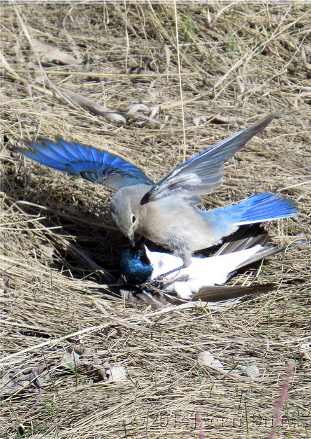
If you space bluebird boxes closer than the recommended distance what can happen?
One pair of bluebirds is normally more than a match for a single pair of swallows. But spacing bluebird boxes closer than 300′ problems can cause problems. Clusters of boxes in one bluebird territory may attract groups of swallows that can mob the lone pair of bluebirds. However, even then truly fit bluebirds, especially older experienced ones, often win out. The proof? Bluebirds commonly secure and defend boxes, and nest successfully, within grids of up to 100 or more active Tree Swallow nests at ornithology research sites. Here in New York bluebirds have raised broods in three of our five swallow projects over the years. Our experience is that if bluebirds really want a box they are very capable of taking it from swallows.
The scene below shows a female Eastern Bluebird dragging a Tree Swallow from a box. Jim Gilbert shot this photo in NJ. Note the species size difference.
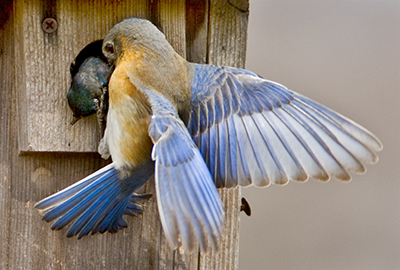
Pairing boxes properly can also reduce Bluebird – Tree Swallow competition.
It is impossible to design a swallow-proof bluebird box because swallows are so much smaller and slimmer than bluebirds. However, there is one technique that proves both songbirds can nest together successfully. This is “pairing;” setting up pairs of boxes, with each box of a pair no more than 5-10 feet apart. Since Tree Swallows seldom let other swallows nest within 10 feet, the second box is usually free for bluebirds. As a result the two species can co-exist, after some initial squabbling to sort out who gets which box. Photo below by Andrew Aldrich.
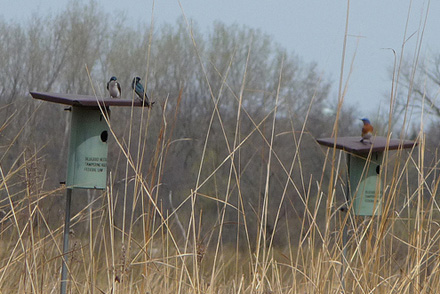
Swallows and bluebirds will even nest in boxes mounted back to back on a single pole. The pictures below are from the ABC Bluebird Trail in Albion, NY. Both boxes held active broods of young.
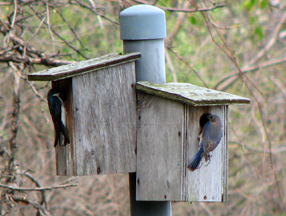
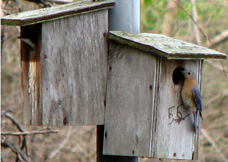
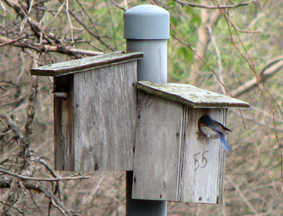
Here’s a YouTube video of Eastern Bluebirds and Tree Swallows bringing food to their broods at another pair of boxes on one pole.
And here’s a video showing the young inside the two neighboring nest boxes.
Does pairing boxes always work? No, of course not. But it is effective often enough that it should be considered when Bluebird – Tree Swallow competition is a concern.
Remember that if you use pairing to reduce Bluebird – Tree Swallow competition, bluebird spacing requirements still apply. Each pair of boxes should still be 300′ or more from the next pair. Spacing them closer defeats the purpose of pairing.

The example below, at a New York nature center, with one pair of boxes in front and a second pair just a short distance behind, shows what not to do. These box pairs should have been located at least 300 feet apart.

So what’s the moral for people concerned by Bluebird – Tree Swallow competition?
People who manage for bluebirds and Tree Swallows do not need be at odds. Bluebirders rightly take pride in how they’ve increased bluebird numbers, and most also realize it’s not a tragedy if other native species occupy some of their boxes. They view these situations as opportunities to enjoy other native species and to learn their ways. They’ve come to value the diversity found among birds.
But aren’t bluebirds in trouble? Don’t they deserve special treatment?
No, they aren’t and they don’t! As we tried to explain earlier, despite what you may have heard or read none of the three bluebird species is endangered or threatened now, and none has been at any time in its recent history. There is nothing unique or inherent about bluebirds that warrants special treatment or favoritism, certainly not at the expense of other native species. There is evidence below.
What are bluebird and Tree Swallow population numbers?
In 2021 Partners In Flight’s Avian Conservation Assessment Database used peer-reviewed scientific methodology to estimate there were 23,000,000 Eastern Bluebirds, 5,600,000 Mountain Bluebirds, and 7,100,000 Western Bluebirds in North America. They estimated Tree Swallows numbered 19,000,000. That’s right, there are more Eastern Bluebirds in this world than Tree Swallows. The database also reports that, while Tree Swallow numbers have declined 40% since 1970, the Eastern Bluebird has increased by 178% during the same period! And most people are very surprised to learn that of the 60 plus species of native Canadian and American landbirds that nest exclusively or almost exclusively in cavities, Eastern Bluebirds are the third most abundant; only House Wrens and Black-capped Chickadees are more numerous.
What is the level of scientific concern regarding the three bluebird species and for Tree Swallows?
In 2021 the Avian Conservation Assessment Database Scores, which includes data from Canada, the United States and Mexico, produced Continental Concern Scores for each North American species. On a scale of 4-20, where higher numbers signify species with greater potential for future vulnerability, Eastern Bluebird received a score of 7, while Tree Swallow received a 10. In other words, the Eastern Bluebird‘s outlook is considered to be better than that for Tree Swallows. Western Bluebird rated a 9. Mountain Bluebird with a 11, had the highest level of concern of these four species. By these criteria birds with scores of 4-8 (Eastern Bluebird) are species of “Least Concern,” while those with scores of 9-13 (Tree Swallow, Western Bluebird and Mountain Bluebird) are species of “Moderate Concern.”
Want to know more about native cavity-nesting landbird populations and levels of concern?
Here’s a chart we compiled using data from Partners in Flight’s 2021 Update of their Avian Conservation Assessment Database populations and concern scores for 61 native North American cavity-nesting landbirds.
What problems do Tree Swallows face?
Tree Swallows lose nesting habitat where northern forests are cut for pulpwood and lumber. Large-scale mining destroys other habitat. Perhaps more importantly, they are steadily losing crucial migration and wintering habitat as coastal wetlands they depend on in the US, Mexico, and Central America are degraded, drained, or converted by humans. Aquaculture, agriculture, industry, housing and infrastructure have all taken their toll.
A more recent risk that threatens wide areas of Tree Swallow migration and wintering habitat is climate change with accompanying rising sea levels. In 2014, Audubon’s “Birds and Climate Change Report” called the Tree Swallow “Climate Threatened“. This species is one of 188 in North America which are “expected to lose more than 50 percent of their current range by 2080 if global warming continues at its current pace.” (Western and Mountain Bluebirds are also considered “Climate Threatened”, but the Eastern Bluebird is not.) Audubon’s scientists predict that Tree Swallow summer and winter ranges will be forced to shift northward, and that successful utilization of more northerly breeding areas will require growth of forests where there are none now, and/or addition of nest boxes.
The rise, fall, and rise of the Eastern Bluebird:
Many bird enthusiasts are becoming aware there are hundreds of species of plants and animals in North America, including many birds, that are much worse off than either bluebirds or Tree Swallows, and which deserve our aid too. With this in mind perhaps some bluebird hobbyists’ goals for bluebird “recovery” or “restoration” should be reconsidered. At this point some historical perspective might help us see why.
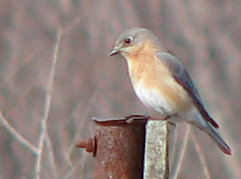
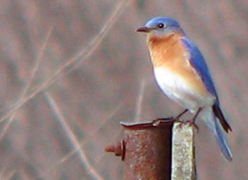
Before its dramatic alteration by humans forests blanketed most of North America east of the Great Plains. Eastern Bluebirds prefer open and semi-open areas with scattered woody vegetation. In the pre-human past they were probably restricted to areas burned over by forest fires and in early stages of regeneration. Burns would have dead trees with cavities, perches for hawking down on insects, and fruit-bearing shrubs typical of early plant succession. However, as old burns returned to forest, bluebirds would have needed to relocate. In any given year most of the eastern forest would have been unsuitable habitat for them. Therefore, under natural, pre-human conditions Eastern Bluebirds were never likely to have been common breeding birds except perhaps locally on burns, and they were certainly never the abundant species that some hobbyist literature and web sites would have you believe.
The human impact:
Then, Native Americans arrived. The clearings they created for farms and villages increased bluebird habitat at the expense of woodland bird species. Fires Native Americans set to create and maintain feeding openings for deer, elk, and bison would also have benefited bluebirds by thinning undergrowth.
But it was when North America was colonized by Europeans that the forests began to be cleared in earnest. By the mid-1800’s the eastern forests were largely gone, replaced by small farms with cropland, pastures and orchards. It’s hard for us to appreciate how completely deforested the land was unless we see photos from the time. Though this was devastating for woodland wildlife, it was a bonanza for bluebirds. The small farms of 19th century rural North America offered vast stretches of new and absolutely perfect open habitat. Bluebirds were able to occupy wide areas where they had never lived before and their numbers skyrocketed. Reducing competition between bluebirds and Tree Swallows wasn’t an issue.
Negative changes since the golden days:
But then things changed once again. Humans introduced House Sparrows from Europe in 1851. European Starlings followed in 1890. As these aggressive non-native cavity nesters multiplied and spread across the continent they out-competed bluebirds for many nest sites.
The small farm, once so prevalent and inviting, also changed. Unprofitable farms were abandoned and slowly but surely returned to forest. On better farms mechanized equipment replaced horses and mules. Small fields were combined into large ones, eliminating hedgerow habitat. The advent of automobiles meant pasturage was not needed for horse-drawn vehicles. “Clean orchards” and dwarf varieties of fruit trees became the rule. Cavities and habitat for bluebirds became scarcer and scarcer.
Then in the 1900’s indiscriminate chemical pesticide use became common, poisoning bluebird food and bluebirds that ate it. Bluebird numbers declined further still. But luckily, by the 1940’s observant people realized this species had become rare in parts of its range compared to the golden days of the 1800’s. They called the alarm and the movement to “bring back the bluebirds” began.
The Eastern Bluebird turnaround:
In recent decades bluebird nest box programs have been very successful. Plus, lawn, park, and cemetery mowing created vast new areas of short-grass habitat that bluebirds quickly utilized. More responsible use of pesticides has certainly helped. The growing popularity of supplemental feeding now aids bluebird survival year-round, especially during the winter months. And although it can’t be proven, competition with House Sparrows and Starlings could be selecting for genetically tougher bluebirds. Let’s hope it’s true. Whatever the reasons, Eastern Bluebirds are common nesters once again across much of eastern and central North America. They have even invaded large sections of Canada and the American west where they had never bred historically. Photo below from Bill Zagar of Michigan.
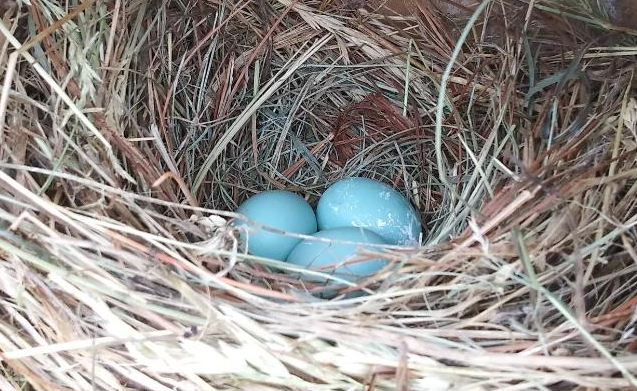
Eastern Bluebirds have faced many challenges in the last 150 years. House Sparrows and Starlings are here to stay. Forests regrew in many places, although still a mere shadow of their former size. The small farms of yesteryear are no more. A couple hundred million more people with houses, cars, highways, buildings and parking lots now occupy much of what was bluebird habitat in the 1800’s. But despite these changes, and with some human help, the Eastern Bluebird has proven its adaptability and is thriving. The “Birds of the World” Eastern Bluebird species report confirms this. It states: “despite concerns about 20th-century fluctuations in numbers, populations may have been more abundant in the 20th and early 21st centuries than in any other period of North American history since the Pleistocene.” Photo below from Bill Zagar.
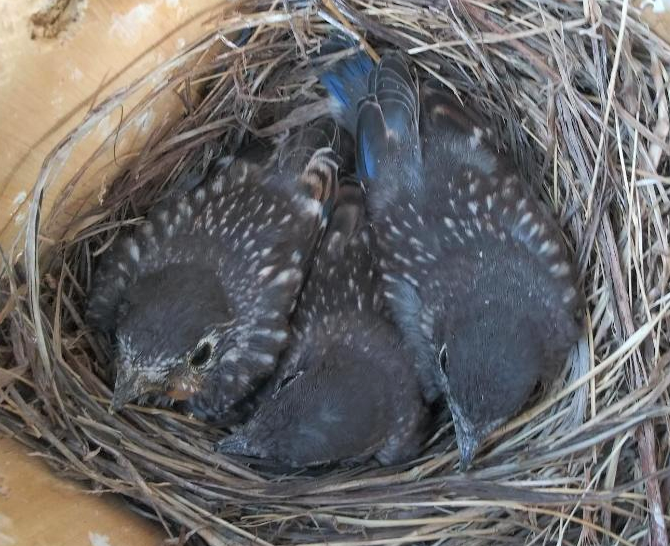
A final word on the subject:
What does all this have to do with reducing human alarms over Bluebird – Tree Swallow competition? As we’ve tried to explain, these concerns are mostly based on the invalid notion that the Eastern Bluebird needs to be “saved.” But, the Eastern Bluebird is actually doing extremely well today. Bluebirds are among the lucky few bird species whose future seems assured. Bluebird hobbyists must recognize that bluebirds never were and never are going to be as abundant as robins, and that having bluebird boxes occupied by Tree Swallows or other native species does not in any way threaten bluebird existence. Rather, it’s our own species’ activities, for better or worse, that will determine population swings of bluebirds, swallows, and most other species on earth, at least in the short run.
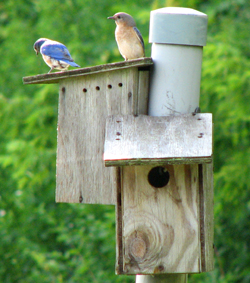
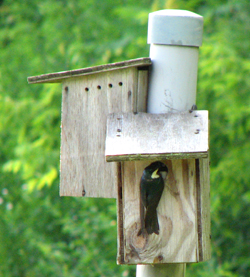
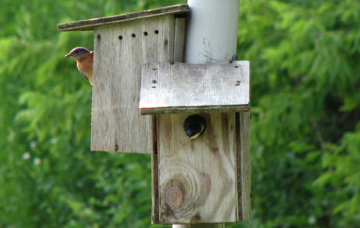
———————————————————————————–
Home: Tree Swallow Nest Box Projects
Creating Tree Swallow Nest Box Projects
Spring Return
Nesting Season Behavior
Song and Calls
Nest Site Claiming
Pair Formation
Nest Building
Bird Flight
Mating and Paternity
Diary of One Season at Salmon Creek
Monitoring Nest Boxes and Keeping Records
Making Box Checks Keeping Box Records Control Sheets Season Summaries Print Sheets
Banding Your Tree Swallows Banding Adults Banding Nestlings
Tree Swallows in Research Research Bibliography Glossary of Terms